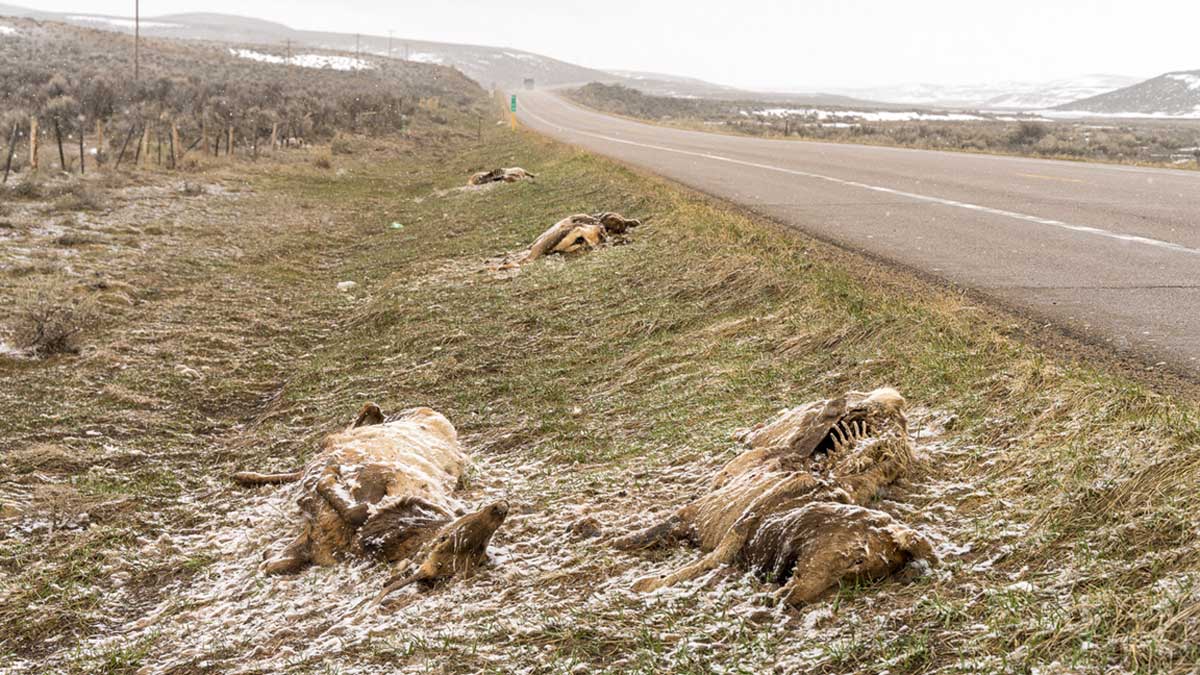Harsh conditions and unrelenting snow during the 2022-23 winter left behind a deadly wake of wildlife. Just ask Paul Queneau, conservation and wildlife editor for the Rocky Mountain Elk Foundation’s Bugle magazine.
Recently traveling through his native Colorado, Queneau turned off Colorado State Highway 13 onto dirt roads that wound through the sagebrush hills between Meeker and Craig where he witnessed a landscape littered with dead animals – mostly elk and pronghorn antelope.
“The smell of death was carried on the wind almost everywhere I went, and almost all of the carcasses I saw didn’t have any magpies or crows feeding on their remains,” lamented Queneau. “I got the feeling there was so much carrion scattered across the landscape that the typical cleanup crew of scavengers had no prayer of keeping up.”
That reality now faces wildlife managers in Colorado as well as Wyoming, Utah, Idaho and possibly Oregon and other western states tasked with making difficult decisions about upcoming hunting seasons.
“For the sake of the current and future health of our big game herds, it is important that all of us, including hunters, rely on and trust biologists and wildlife managers to make science-based decisions in determining responsible, reasonable license allocations for this hunting season and beyond,” said Blake Henning, RMEF chief conservation officer. “As overseers of our elk, mule and whitetail deer, pronghorn antelope, moose and other populations, they monitor overall herd health in line with the North American Wildlife Conservation Model, so those populations will be forever sustained.”
At its May commission meeting, Colorado Parks and Wildlife (CPW) game managers recommended reduction of about 25,000, or 12 percent from 2022 of statewide deer, elk and pronghorn licenses, including unprecedented license reductions in the severe winter zone from Rangely to Steamboat Springs and the Wyoming state line. Those recommendations include 48 percent fewer either-sex deer licenses and 94 percent fewer antlerless deer tags. CPW also recommended a 25 percent reduction of statewide antlerless elk tags, including 94 percent fewer cow tags in the Bears Ears and White River Data Analysis Areas.
“Quite frankly they’re necessary to protect our valuable wildlife resources and give them the chance to bounce back quickly, which I think they will,” Travis Flaharty told the Daily Sentinel, a northwest Colorado outfitter who freely admitted the reductions will affect his livelihood.
Some 300 miles to the west, high in the Wasatch Mountains of northern Utah, excessively deep snow is the issue. How deep? Alta Ski Resort reported an astounding, record-setting snowpack measuring 900 inches when it closed its lifts in late April. That’s 75 feet of snow!
The Utah Division of Wildlife Resources (DWR) took steps throughout the winter to try to help wildlife including emergency deer feeding due to deep snow and poor deer condition as well as statewide restrictions for shed antler hunting to help protect wintering big game. In April, DWR closed 24 WMAs (wildlife management areas) in northern Utah, again to protect winter range, and extended the closure on four of those WMAs into mid-May. It later announced an 11 percent decrease in the number of 2023 general season deer hunting permits.
In Idaho, game managers monitoring calf and doe survival in the eastern part of the state eliminated antlerless mule deer hunts for this fall just months after planning to expand such opportunities. They also initiated emergency feeding at more than 50 different locations and closed WMAs.
As of late March, wildlife managers estimated more than 500 pronghorn died in western Wyoming. Mule deer losses may be similar although an accurate assessment of all wildlife species is not expected until the snow melts. In late April, Wyoming Game and Fish announced an emergency extended closure of shed antler and horn hunting until May 15.
Back in Colorado, Queneau did see some large herds of elk, deer and a few pronghorn that survived the cruel winter, but not without consequences.
“The elk in particular were walking ribcages, animals clearly depleted of all their fat and much of their muscle from starvation. Biologists I spoke with feared not only the extent of the winterkill, but also that no viable calves may be born this spring, either stillborn or so underweight that they don’t have any chance of survival,” said Queneau.
History shows short-term sacrifices by hunters because of reduced tag allocations due to severe winter events, catastrophic wildfires or other issues, coupled with strong and whole habitats, allow herds to recover to healthy, sustainable levels.
(Photo credit: Rocky Mountain Elk Foundation)
